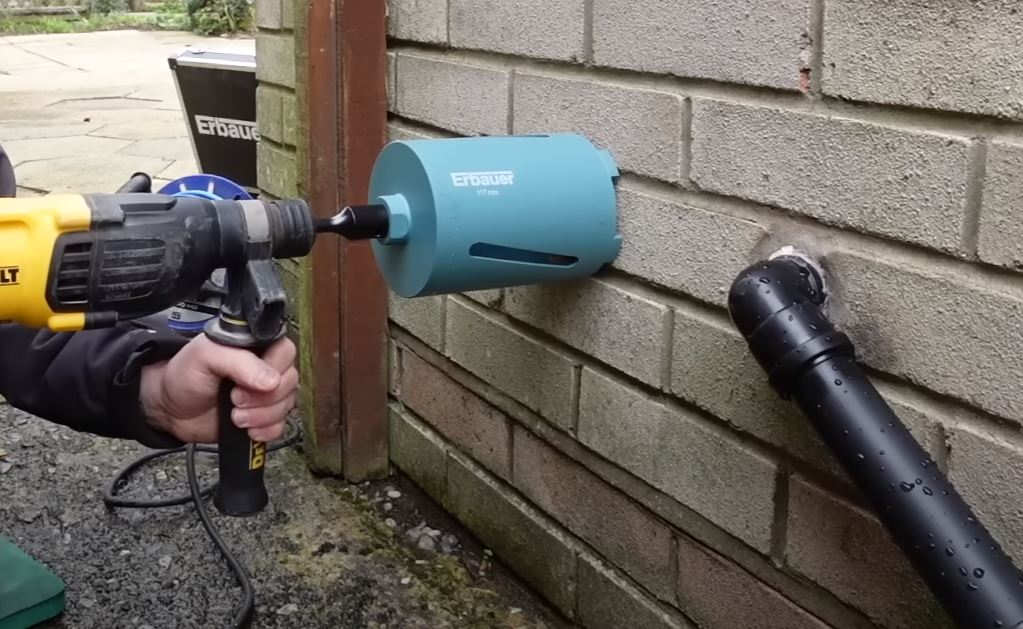Concrete’s Dual Strength
Concrete, a wonder material in the construction world, boasts two primary strengths: compressive and tensile.
- Compressive Strength: This is the resistance of a material to breaking under compression. For concrete, this strength is notably high, making it a popular choice for structures that endure significant loads.
- Tensile Strength: Unlike its compressive counterpart, the tensile strength of concrete – its resistance to breaking under tension – is notably lower.
The juxtaposition of these strengths forms the heart of concrete’s uniqueness. While it can bear heavy loads pushing down on it, it becomes vulnerable when pulled apart, even slightly.
The Drilling Process and Tensile Strength
Concrete drilling is more than just breaking through a surface; it’s a technical process that exerts various stresses on the material.
- Induced Tension: Drilling can induce tension around the hole, which might be problematic due to concrete’s lower tensile strength. It can potentially lead to cracks, especially if not done correctly.
- Importance in Home Renovations: For Aucklanders looking to undertake concrete coring for home renovations, understanding this tensile vulnerability is crucial. It informs the techniques and precautions needed to maintain the integrity of the structure.
Auckland’s Unique Bylaw Considerations
Auckland’s diverse architecture and historical precincts demand special considerations. Suburbs like Herne Bay and Remuera come with specific bylaws due to their historical importance.
- Herne Bay: Recognised for its preserved villas and heritage, drilling operations here need to be especially wary of inducing any tension in concrete structures, given the potential for aged concrete to be even more susceptible to tensile stresses.
- Remuera: Characterised by both modern and heritage buildings, drilling without adequate consideration of tensile strength could compromise structures, especially those of historical significance.
Both suburbs highlight the broader implications of Auckland Council regulations that address concrete drilling and preservation of structural integrity, underlining the significance of tensile strength considerations.
Advancements in Drilling Techniques
The world of Auckland concrete cutting has seen innovations tailored to address the tensile limitations of concrete.
- Wet Drilling: A technique that, apart from dust suppression, aids in reducing tension around the drilling site by keeping the concrete cool and preventing potential heat-induced tension.
- Diamond Core Drilling: Preferred for its precision, this method induces minimal stress on the surrounding concrete, making it ideal for structures where maintaining tensile integrity is paramount.
Ensuring Safe Concrete Drilling
Aucklanders seeking concrete coring for renovations should be keenly aware of:
- Depth and Diameter: Drilling too deep or creating a hole too wide can amplify the tension in the surrounding concrete, increasing the risk of cracks.
- Location Matters: Avoid drilling near the edge of a concrete slab or too close to other holes, as this area has already endured tension and can be more vulnerable.
- Continuous Monitoring: Engaging with professionals in Auckland concrete cutting ensures that drilling is continually monitored, reducing risks associated with tensile stresses.
The Crucial Role of Reinforcements
Given the tensile vulnerabilities of concrete, reinforcements like rebar play a critical role:
- Strength Enhancement: Reinforcements increase the tensile strength of concrete, making it more resistant to potential cracks during drilling operations.
- Concrete Coring Considerations: While reinforcements bolster tensile strength, they present their challenges. Hitting a rebar while drilling can halt the process and even damage equipment. Techniques like Ground Penetrating Radar (GPR) are used to detect such reinforcements before drilling, ensuring smoother operations.
Concrete: A Balance of Strengths
The beauty of concrete lies in its duality. While robust under compression, its tensile vulnerabilities are what Auckland concrete cutting professionals navigate daily. For Aucklanders exploring home renovations, an appreciation of these nuances ensures safer, more efficient concrete coring processes.
Understanding the science behind these strengths, staying updated with Auckland’s evolving bylaws, and leveraging the latest in concrete drilling techniques ensures that this age-old construction material remains resilient and enduring, even in the face of modern challenges.
Frequently Asked Questions about Concrete’s Tensile Strength and Drilling in Auckland
Why is tensile strength a concern when concrete has such high compressive strength?
While concrete is incredibly strong under compression (pushing forces), it’s much weaker under tension (pulling forces). Drilling can introduce tensile stresses, potentially leading to cracks or weakening the structure.
I’m planning a home renovation in Herne Bay; any special considerations I should be aware of?
Yes, due to Herne Bay‘s historical significance and the presence of preserved villas, it’s crucial to consider the age and tensile strength of the concrete. Drilling in such areas might require extra precautions to avoid compromising older structures.
What’s the difference between wet drilling and diamond core drilling?
Wet drilling keeps the concrete cool and reduces dust, minimising tension around the drill site. Diamond core drilling uses a diamond-embedded drill bit for precision and introduces minimal stress, ideal for structures where tensile integrity is paramount.
Can I drill into concrete that has rebar reinforcements?
Absolutely, but it requires care. While reinforcements bolster concrete’s tensile strength, hitting rebar during concrete drilling can halt the process and damage equipment. It’s recommended to use techniques like Ground Penetrating Radar to detect rebar before drilling.
I live in Remuera and want to drill into a heritage building’s concrete. What should I keep in mind?
Drilling in areas like Remuera, with both modern and heritage buildings, requires an understanding of concrete’s tensile vulnerabilities. It’s vital to employ Auckland concrete cutting professionals who can ensure the structural and historical integrity of such buildings.
How can I ensure the drilling process doesn’t introduce too much tension?
Engage with professionals in Auckland concrete cutting. They can monitor the drilling continuously, choose the appropriate drilling technique, and ensure that depth, diameter, and location considerations are all taken into account.
Why is drilling near the edge of a concrete slab riskier?
Edges have already endured some level of tension. Drilling too close to them can amplify the stress, increasing the potential for cracks or structural compromises.
Does tensile strength vary between different types of concrete?
Yes, tensile strength can vary based on the concrete’s composition, age, and any additives or reinforcements present. It’s always wise to consult with a concrete expert before drilling.
What advancements in concrete drilling have been developed to consider tensile strength?
The Auckland concrete cutting industry has introduced methods like wet drilling and diamond core drilling, tailored to minimise tensile stresses. Moreover, equipment with depth control and laser-guidance ensures precise and safe drilling.
What happens if the tensile strength is overlooked during the drilling process?
Overlooking tensile strength can lead to structural issues such as cracks, fractures, or even more severe damage, compromising the safety and aesthetics of the structure.

